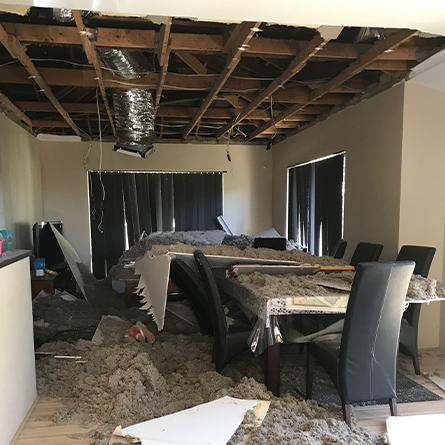Ceiling collapses can be sudden and alarming events, posing significant risks to occupants and property. Whether caused by structural damage, water leaks, or other factors, a ceiling collapse requires immediate attention to ensure safety and prevent further damage. In this guide, we’ll explore what to do in the event of a ceiling collapse, who to call for assistance, and essential safety measures to take.

Understanding Ceiling Collapse
A ceiling collapse occurs when the structural integrity of a ceiling is compromised, leading to its sudden failure and collapse. Common causes of ceiling collapses include:
- Water Damage: Leaking pipes, roof leaks, or flooding can weaken ceiling materials over time, leading to structural failure.
- Structural Defects: Poor construction, age-related deterioration, or inadequate support can contribute to ceiling collapses.
- Natural Disasters: Severe weather events such as earthquakes, hurricanes, or heavy snowfall can cause ceilings to collapse.
Signs of a Potential Ceiling Collapse
It’s essential to be vigilant for warning signs that may indicate a ceiling is at risk of collapsing. Signs of potential ceiling collapse include:
- Cracks or Sagging: Visible cracks, bulges, or sagging areas in the ceiling may indicate structural damage.
- Water Stains: Water stains or discoloration on the ceiling could be a sign of water damage and weakening of materials.
- Strange Sounds: Unusual noises such as creaking, popping, or shifting sounds coming from the ceiling should be investigated promptly.
What to Do in Case of a Ceiling Collapse
In the event of a ceiling collapse, follow these steps to ensure safety and mitigate risks:
- Evacuate Immediately: If a ceiling collapse occurs, evacuate the area immediately to a safe location outside the building.
- Assess the Situation: Once outside, assess the extent of the damage and ensure that everyone is accounted for.
- Contact Emergency Services: Call emergency services (such as 911) to report the incident and request assistance from firefighters and paramedics if needed.
- Document the Damage: Take photos or videos of the collapsed ceiling and any associated damage for insurance purposes.
- Secure the Area: Block off the affected area to prevent access and potential injuries from falling debris.
- Contact a Professional: After ensuring everyone’s safety, contact a licensed contractor or structural engineer to assess the damage and recommend repairs.
Who to Call for Assistance
In the event of a ceiling collapse, it’s essential to contact the following parties for assistance:
- Emergency Services: Call 911 or your local emergency number to report the incident and request immediate assistance.
- Building Management: If the ceiling collapse occurs in a commercial or residential building, notify the building management or landlord.
- Insurance Provider: Contact your insurance provider to report the incident and initiate the claims process for property damage.
Safety Tips for Ceiling Collapse Prevention
To reduce the risk of a ceiling collapse, consider the following safety tips:
- Regular Inspections: Schedule regular inspections of your property’s ceilings to identify and address any signs of damage or deterioration.
- Address Water Damage: Promptly repair any water leaks or damage to prevent moisture buildup and structural damage.
- Avoid Overloading Ceilings: Avoid hanging heavy objects or equipment from ceilings, as this can strain the structural integrity.
- Monitor Weather Conditions: Stay informed about severe weather warnings and take precautions to protect your property from potential damage.
Conclusion
A ceiling collapse can be a frightening and dangerous situation, but knowing what to do and who to call can help mitigate risks and ensure a prompt response. By following the steps outlined in this guide and prioritizing safety, you can protect yourself, your loved ones, and your property in the event of a ceiling collapse emergency.